Charles E W Bean, Diaries, AWM38 3DRL 606/246/1 - 1916 - 1929 - Part 11
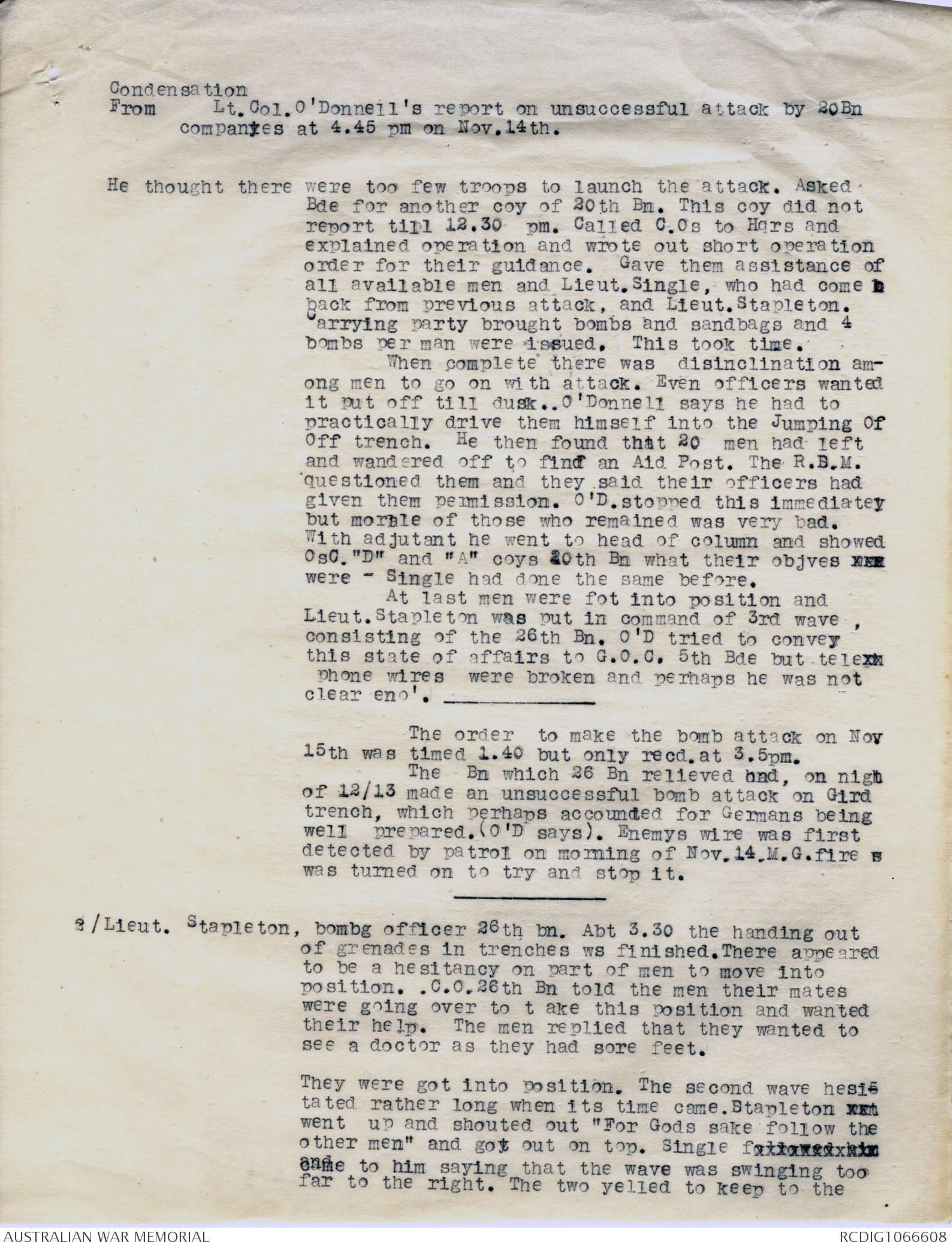
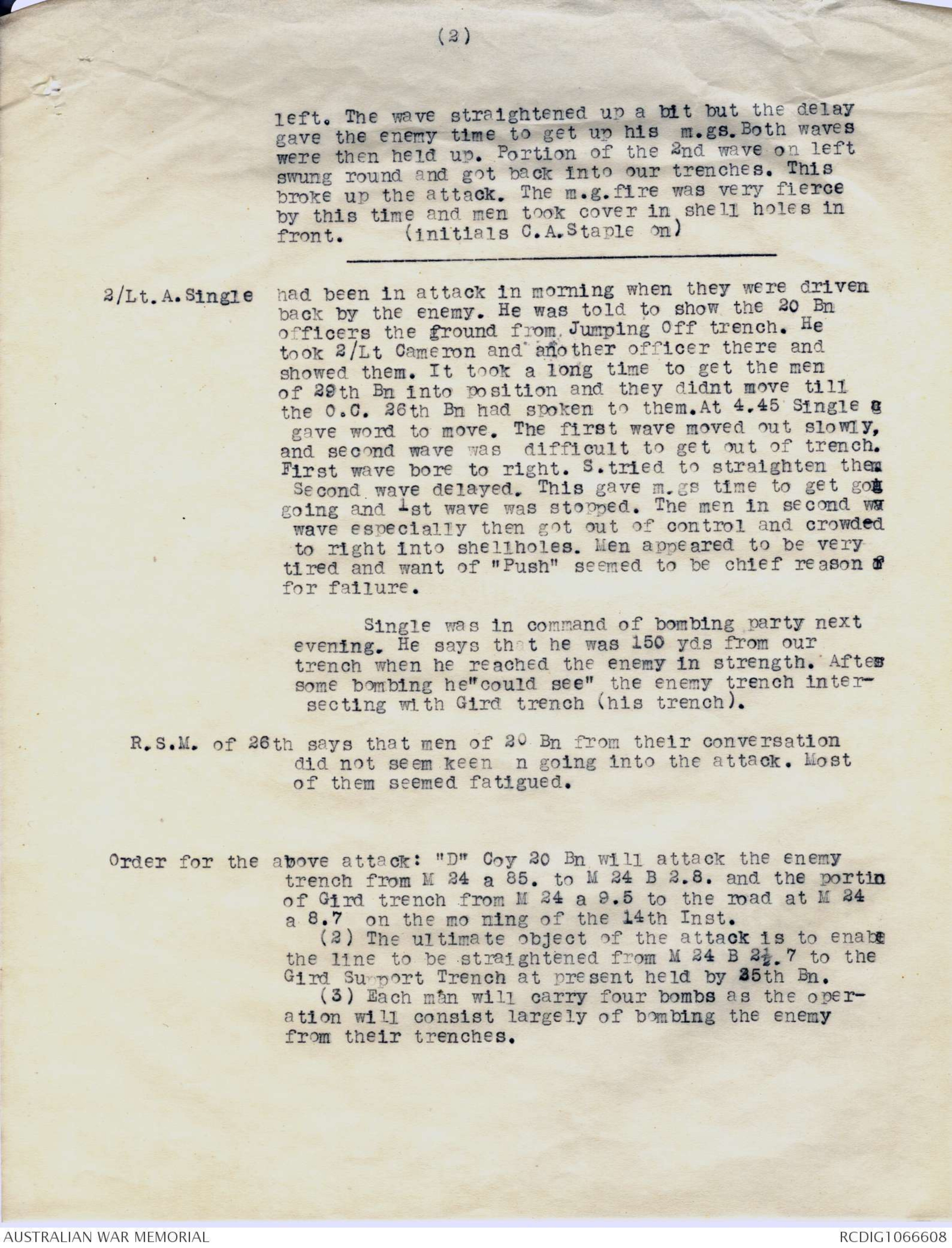
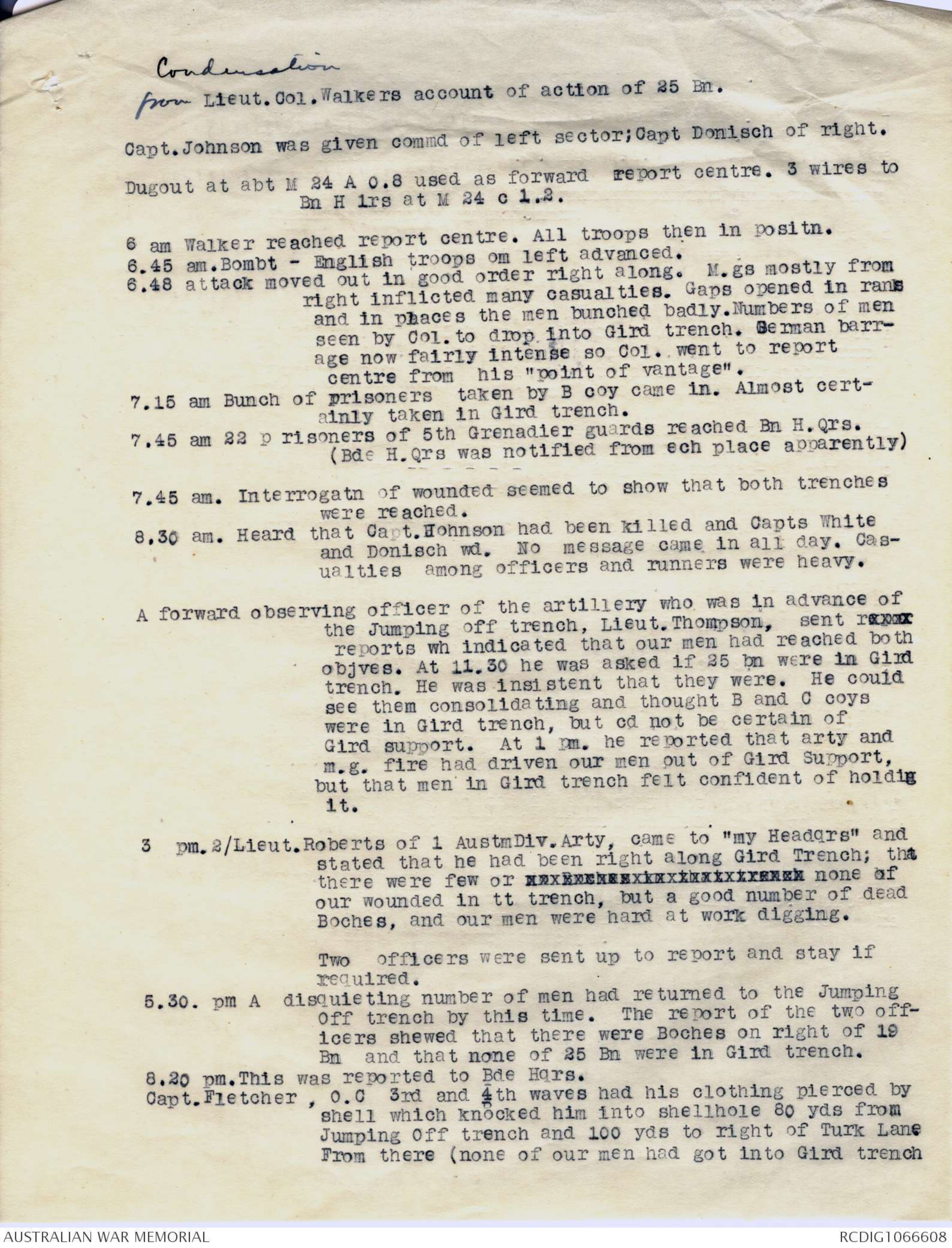

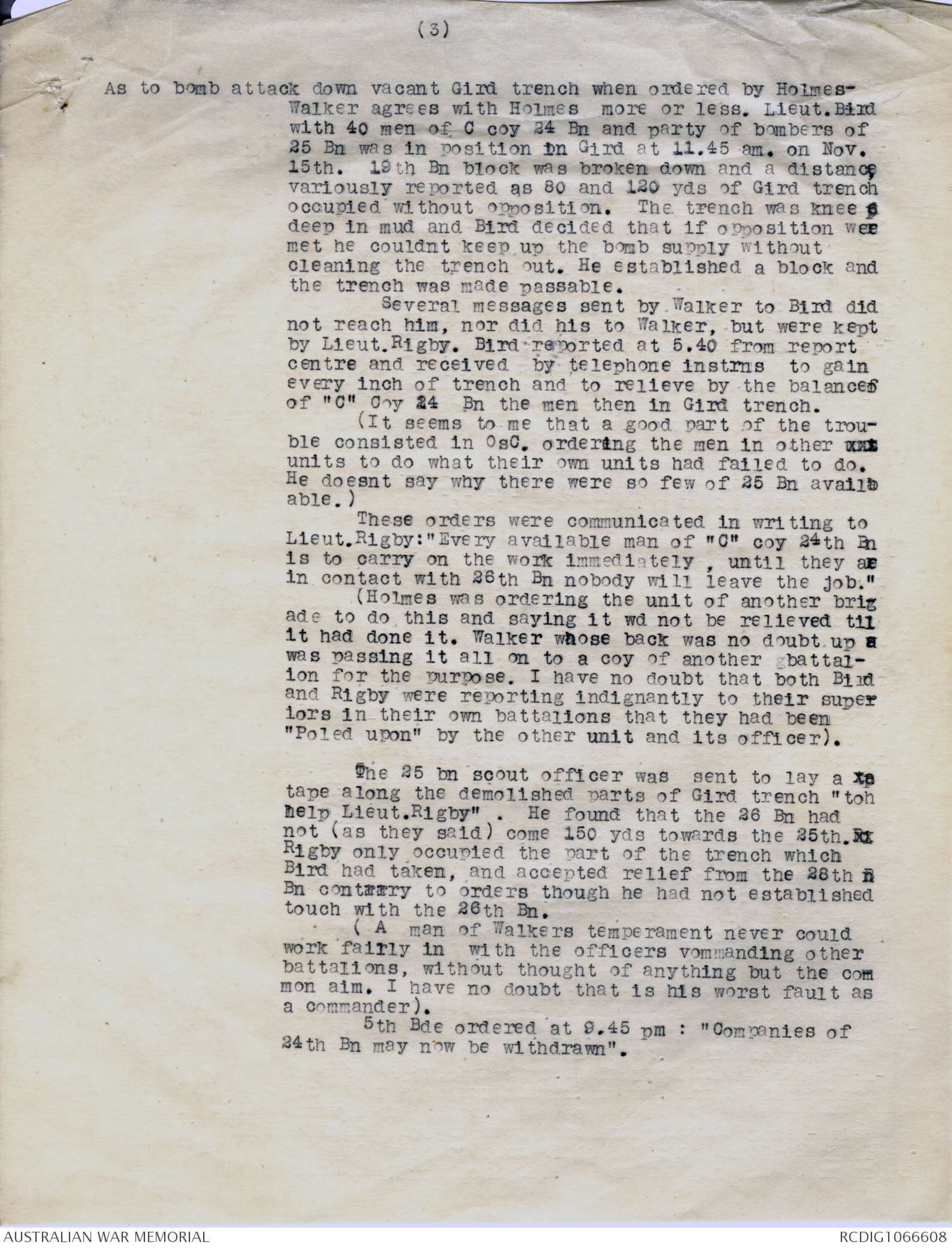
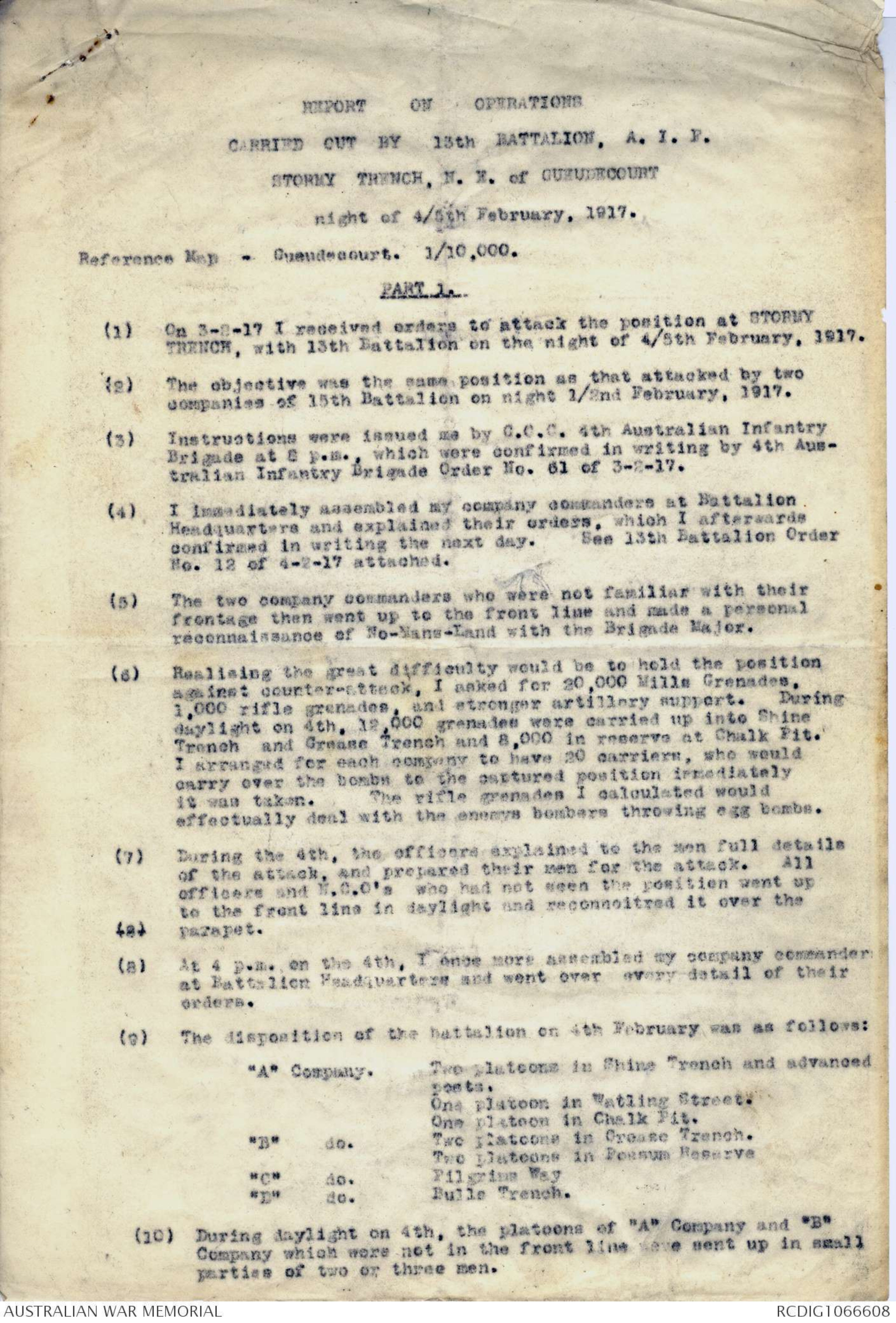
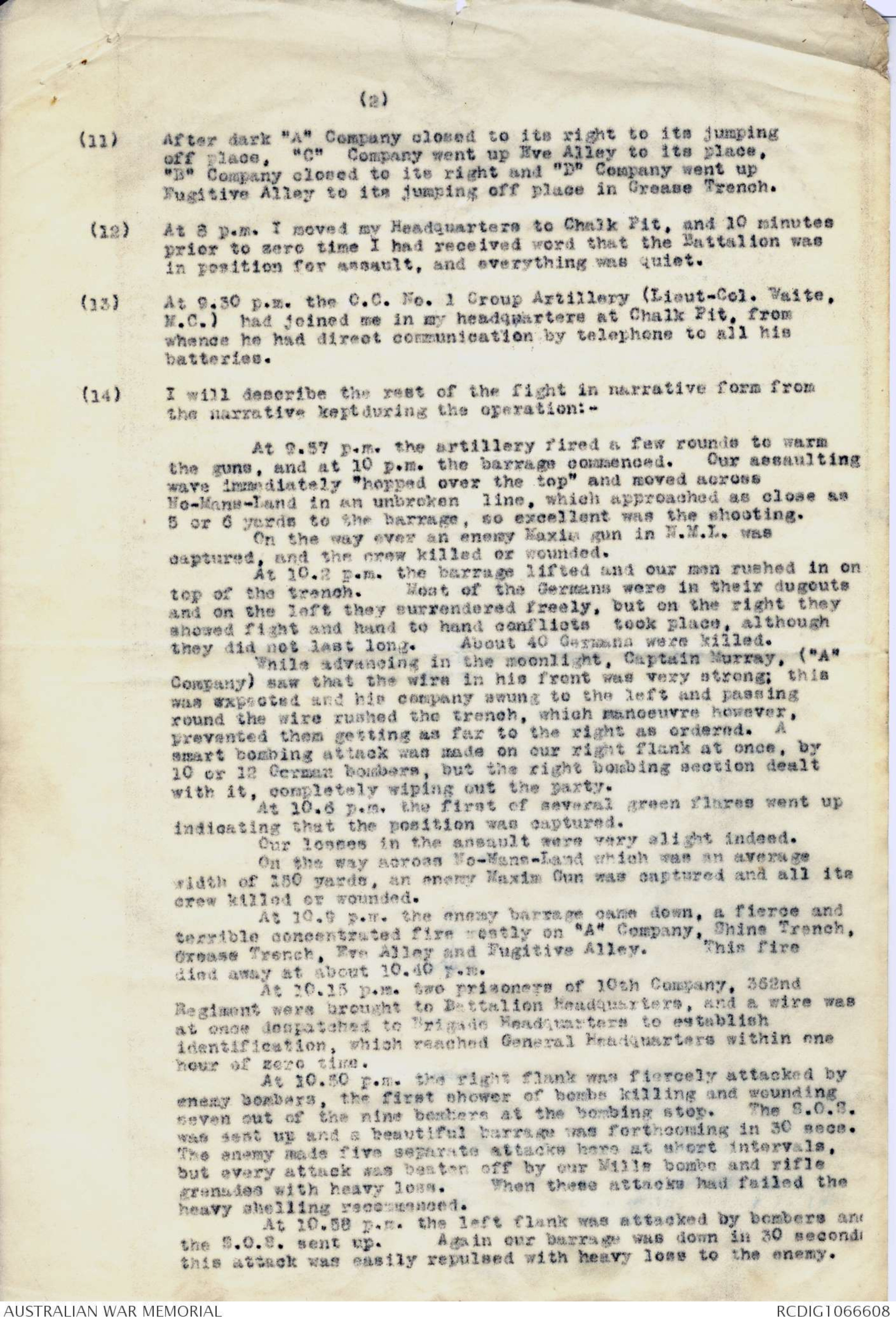
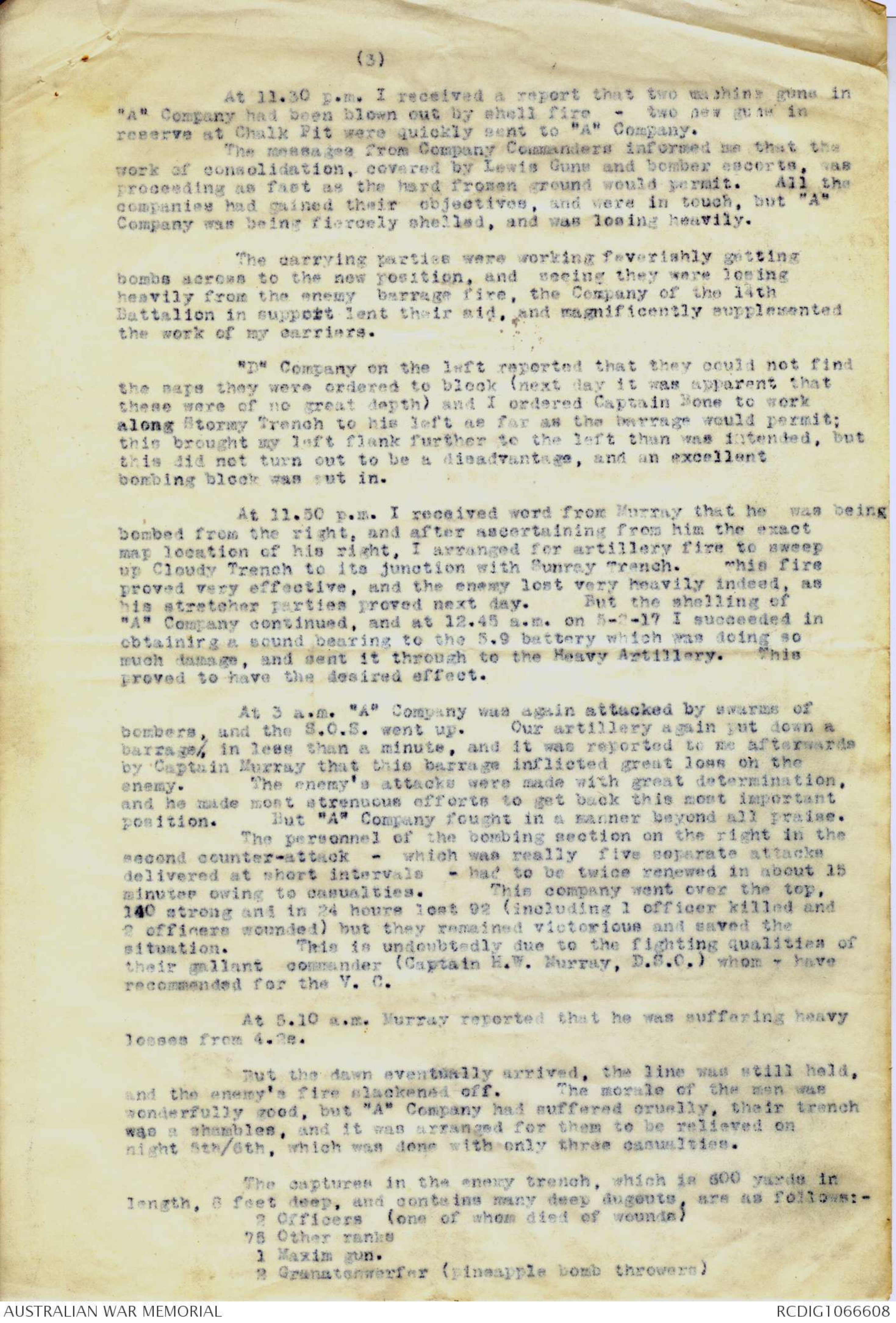
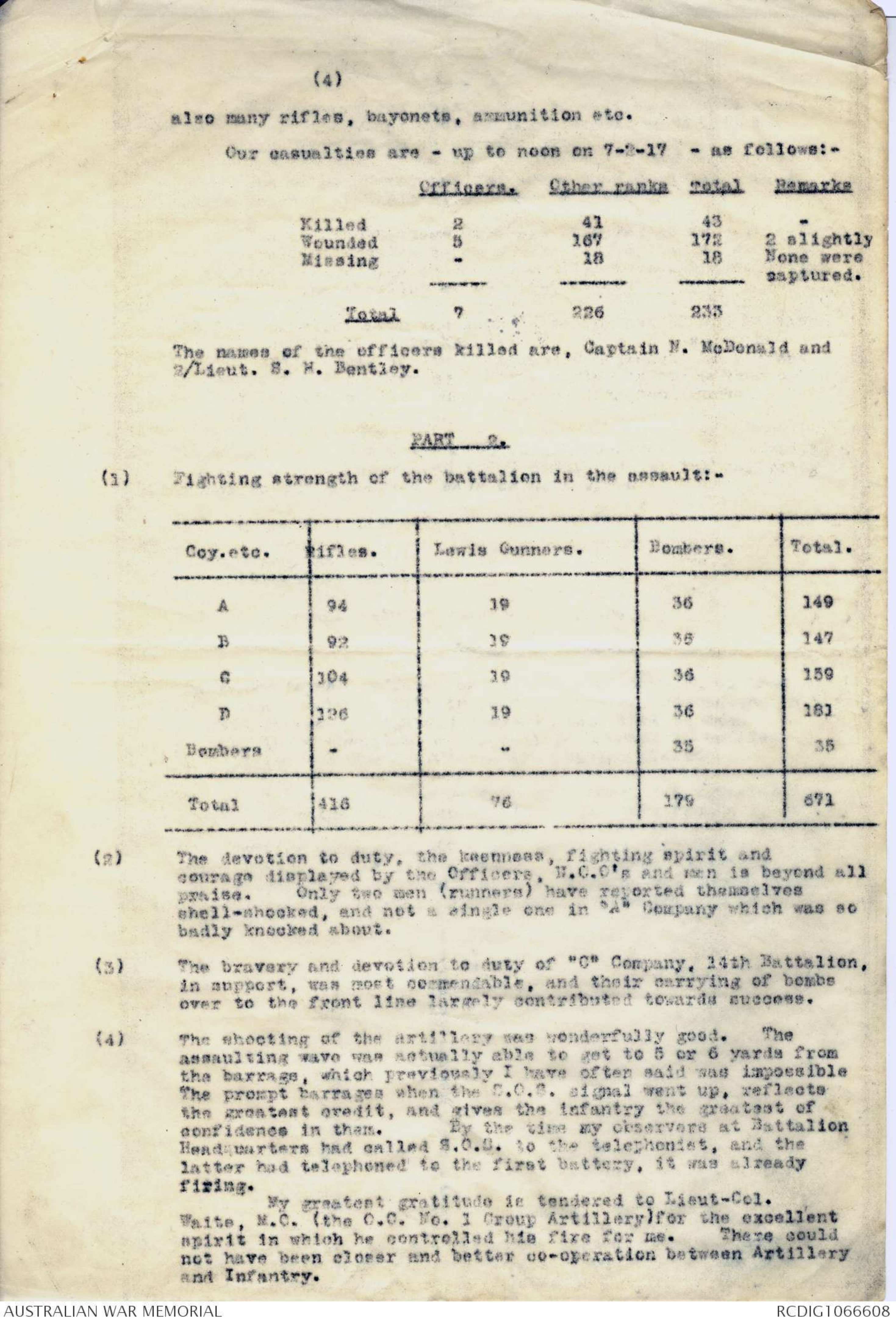
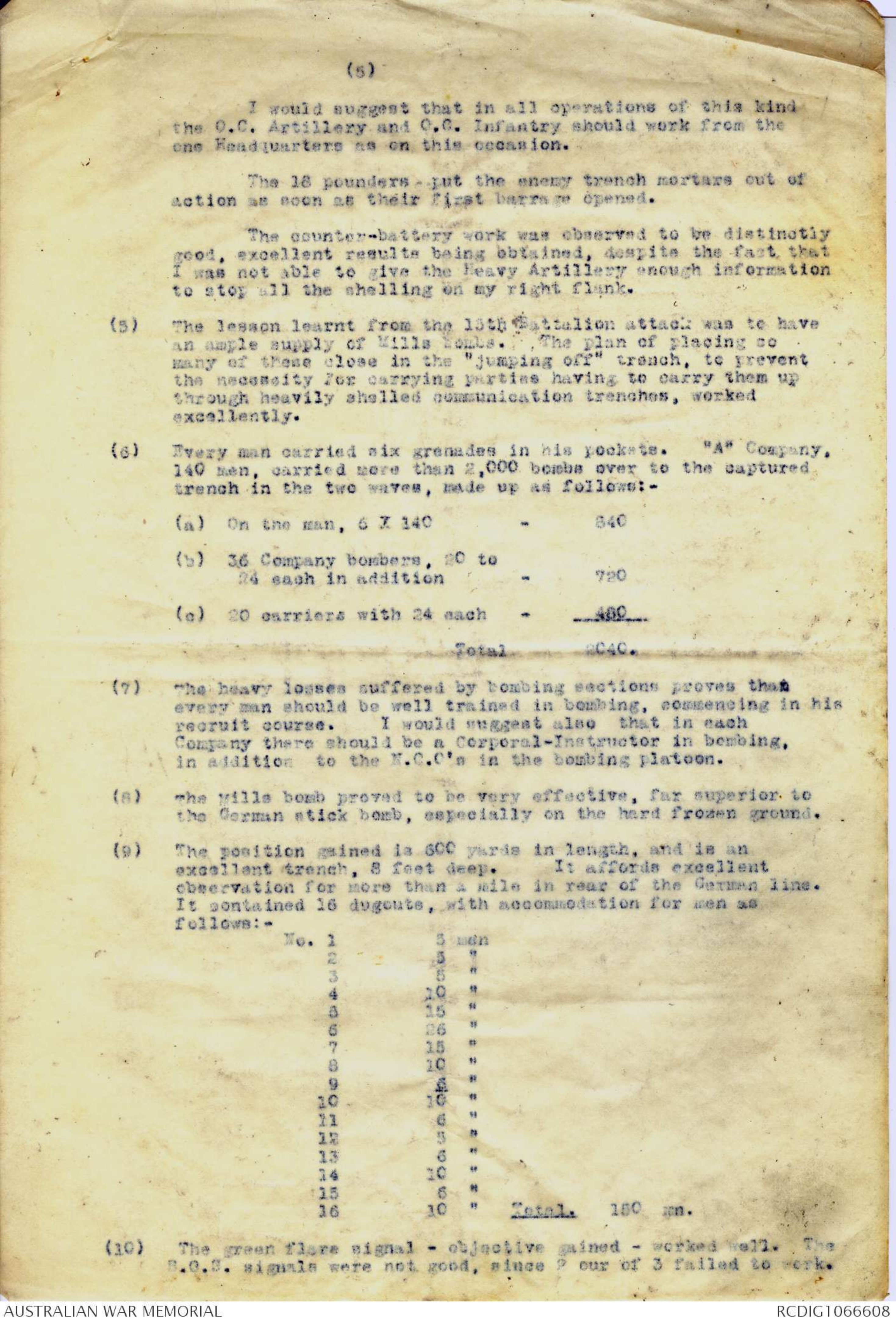
Condensation
From Lt.Col.O'Donnell's report on unsuccessful attack by 20Bn
companyies at 4.45 pm on Nov. 14th.
He thought there were too few troops to launch the attack. Asked
Bde for another coy of 20th Bn. This coy did not
report till 12.30 pm. Called C.Os to Hqrs and
explained operation and wrote out short operation
order for their guidance. Gave them assistance of
all available men and Lieut.Single, who had come h
back from previous attack, and Lieut. Stapleton.
Carrying party brought bombs and sandbags and 4
bombs per man were issued. This took time.
When complete there was disinclination among
men to go on with attack. Even officers wanted
it put off till dusk.. O'Donnell says he had to
practically drive them himself into the Jumping Of
Off trench. He then found that 20 men had left
and wandered off to find an Aid Post. The R.B.M.
questioned them and they said their officers had
given them permission. O'D.stopped this immediately
but morale of those who remained was very bad.
With adjutant he went to head of column and showed
OsC."D" and "A" coys 20th Bn what their objves xxx
were - Single had done the same before.
At last men were fot into position and
Lieut.Stapleton was put in command of 3rd wave,
consisting of the 26th Bn. O'D tried to convey
this state of affairs to G.O.C. 5th Bde but telexx
phone wires, were broken and perhaps he was not
clear eno'.
The order to make the bomb attack on Nov
15th was timed 1.40 but only recd.at 3.5pm.
The Bn which 26 Bn relieved had, on night
of 12/13 made an unsuccessful bomb attack on Gird
trench, which perhaps accounted for Germans being
well prepared.(O'D says). Enemys wire was first
detected by patrol on morning of Nov.14.M.G.fire s
was turned on to try and stop it.
2/Lieut. Stapleton, bombg officer 26th bn. Abt 3.30 the handing out
of grenades in trenches ws finished. There appeared
to be a hesitancy on part of men to move into
position..C.O.26th Bn told the men their mates
were going over to take this position and wanted
their help. The men replied that they wanted to
see a doctor as they had sore feet.
They were got into position. The second wave hesitated
rather long when its time came. Stapleton wet
went up and shouted out "For Gods sake follow the
other men" and got out on top. Single followed himand came to him saying that the wave was swinging too
far to the right. The two yelled to keep to the
(2)
left. The wave straightened up a bit but the delay
gave the enemy time to get up his m.gs.Both waves
were then held up. Portion of the 2nd wave on left
swung round and got back into our trenches. This
broke up the attack. The m.g.fire was very fierce
by this time and men took cover in shell holes in
front. (initials C.A.Stapleton)
2/Lt.A.Single had been in attack in morning when they were driven
back by the enemy. He was told to show the 20 Bn
officers the ground from Jumping Off trench. He
took 2/Lt Cameron and another officer there and
showed them. It took a long time to get the men
of 29th Bn into position and they didnt move till
the O.C. 26th Bn had spoken to them.At 4.45 Single g
gave word to move. The first wave moved out slowly
and second wave was difficult to get out of trench.
First wave bore to right. S.tried to straighten them.
Second wave delayed. This gave m.gs time to get gog
going and 1st wave was stopped. The men in second wa
wave especially then got out of control and crowded
to right into shellholes. Men appeared to be very
tired and want of "Push" seemed to be chief reason r
for failure.
Single was in command of bombing party next
evening. He says that he was 150 yds from our
trench when he reached the enemy in strength. After
some bombing he "could see" the enemy trench intersecting
with Gird trench (his trench).
R.S.M. of 26th says that men of 20 Bn from their conversation
did not seem keen n going into the attack. Most
of them seemed fatigued.
Order for the above attack: "D" Coy 20 Bn will attack the enemy
trench from M 24 a 85. to M 24 B 2.8. and the portin
of Gird trench from M 24 a 9.5 to the road at M 24
a 8.7 on the mo ning of the 14th Inst.
(2) The ultimate object of the attack is to enable
the line to be straightened from M 24 B 2½.7 to the
Gird Support Trench at present held by 25th Bn.
(3) Each man will carry four bombs as the operation
will consist largely of bombing the enemy
from their trenches.
Condensation
from Lieut. Col.Walkers account of action of 25 Bn.
Capt. Johnson was given commd of left sector;Capt Donisch of right.
Dugout at abt M 24 A 0.8 used as forward report centre. 3 wires to
Bn Hdrs at M24 c1.2.
6 am Walker reached report centre. All troops then in positn.
6.45 am. Bombt - English troops om left advanced.
6.48 attack moved out in good order right along. M.gs mostly from
right inflicted many casualties. Gaps opened in ranks
and in places the men bunched badly. Numbers of men
seen by Col. to drop into Gird trench. German barrage
now fairly intense so Col. went to report
centre from his "point of vantage".
7. 15 am Bunch of prisoners taken by B coy came in. Almost certainly
taken in Gird trench.
7.45 am 22 prisoners of 5th Grenadier guards reached Bn H.Qrs
(Bde H.Qrs was notified from ech place apparently)
7.45 am. Interrogatn of wounded seemed to show that both trenches
were reached.
8.30 am. Heard that Capt. Johnson had been killed and Capts White
and Donisch wd. No message came in all day. Casualties
among officers and runners were heavy.
A forward observing officer of the artillery who was in advance of
the Jumping off trench, Lieut. Thompson, sent rxxxr
reports wh indicated that our men had reached both
objves. At 1l.30 he was asked if 25 bn were in Gird
trench. He was insistent that they were. He could
see them consolidating and thought B and C coys
were in Gird trench, but cd not be certain of
Gird support. At 1 pm. he reported that arty and
m.g. fire had driven our men out of Gird Support,
but that men in Gird trench felt confident of holding
it.
3 pm.2/Lieut. Roberts of 1 AustmDiv.Arty, came to "my Headqrs" and
stated that he had been right along Gird Trench; that
there were few or no Boches in that trench none of
our wounded in tt trench, but a good number of dead
Boches, and our men were hard at work digging.
Two officers were sent up to report and stay if
required.
5.30. pm A disquieting number of men had returned to the Jumping
Off trench by this time. The report of the two officers
shewed that there were Boches on right of 19
Bn and that none of 25 Bn were in Gird trench.
8.20 pm.This was reported to Bde Hqrs.
Capt. Fletcher O.C 3rd and 4th waves had his clothing pierced by
shell which knocked him into shellhole 80 yds from
Jumping Off trench and 100 yds to right of Turk Lane
From there (none of our men had got into Gird trench
(2)
on left) he saw at abt 7.5 am 10 or 12 German rifle
men come out opposite him from Gird trench and extend
to right, in front of destroyed wire. On their
left (? his right) were 3 machine guns 30 yds apart
the centre one straight in front of him, also in
front of their wire. Riflemen sniped and Fletchersays he shot some. To east of m.gs Fletcher cd see
Germans bombing to their left flank. He saw some of
our men moving from shellhole to shellhole away from
this position. He came in after dark.
Walker says failure was due to men not being in good heart owing to
exposure and hard times during previous 10 days;
and to waves being not thick enough - extension
to 4 pr 5 yds, causing bunching and loss of
direction and giving play to their tendency to drop
into shellholes.
casualties- 5 officers out of 6.
65 per cent other ranks.
At 3 am when ordered by Holmes to attack he had C Coy 24 bn in
jumping off trench; 25th men in forward trenches
had bn organised into another coy; 2 sections of
bombing platoon were still intact.
Lt Col. Forbes was in Walkers Hqrs also. Walker chose
a silent frontal attack before dawn because he doubted
his ability to maintain the bomb supply to troops
attacking. Forbes issued Walkers orders to his boys
in accordance with orders handed him by Walker. Lieut
Bird 25 Bn as senior officer then in trenches was
made O.C.attack. The attack was to leave trenches at
4.55 and move silently across Nomansland. Artillery
action -viz.barrage at 5 am and in rear and on right
of objve was arranged through liaison officer at
bn Hqrs. Orders left Hqrs at 3.25 am but did not rea
reach Bird till 4.20 am. He immediately saw Lieut.
Rigby O.C "C" coy 24th bn, to whom a copy was also
sent. Rigby wd not proceed with orders but at once
came down to Bn Hqrs. arriving there between 5.25
and 5.30 am. This was first intimatn that attack was
not in progress. Rigby based his action on the orders
being not very legible. Bird had however shown him
his own - the original- copy. Zero hour put off to
6.15.am and Rigby sent back with orders to carry on.
Forbes concurred. At 5.58 Bird received notice, but
he thinking the attack wd not take place owing to
Rigbys dep rture, had not issued grenades, rations r
or filled waterbottles. He went to report centre to
telephone for instrns. As morning was misty Walker
ordered attack to be carried out. Bird communicated
this to Rigby, but Capt.Godfrey of 24 bn wd not permit
Rigby to carry the order out. Attack therefore
never took place.
(As to this, Walker seems to have done as much as anyone - viz
ordered someone else to do something several times
which they did not do).
(3)
As to bomb attack down vacant Gird trench when ordered by Holmes-
Walker agrees with Holmes more or less. Lieut. Bird
with 40 men of C coy 24 Bn and party of bombers of
25 Bn was in position in Gird at 11.45 am. on Nov.
15th. 19th Bn block was broken down and a distance
variously reported as 80 and 120 yds of Gird trench
occupied without opposition. The trench was knee a
deep in mud and Bird decided that if opposition were
met he couldnt keep up the bomb supply without
cleaning the trench out. He established a block and
the trench was made passable.
Several messages sent by Walker to Bird did
not reach him, nor did his to Walker, but were kept
by Lieut.Rigby. Bird reported at 5.40 from report
centre and received by telephone instrns to gain
every inch of trench and to relieve by the balances
of "C" Coy 24 Bn the men then in Gird trench.
(It seems to me that a good part of the trouble
consisted in OsC. ordering the men in other unt
units to do what their own units had failed to do.
He doesnt say why there were so few of 25 Bn available.)
These orders were communicated in writing to
Lieut.Rigby:"Every available man of "C" coy 24th Bn
is to carry on the work immediately, until they are
in contact with 26th Bn nobody will leave the job."
(Holmes was ordering the unit of another brigade
to do this and saying it wd not be relieved til
it had done it. Walker whose back was no doubt up a
was passing it all on to a coy of another gbattalion
for the purpose. I have no doubt that both Bird
and Rigby were reporting indignantly to their superiors
in their own battalions that they had been
"Poled upon" by the other unit and its officer).
The 25 bn scout officer was sent to lay a xx
tape along the demolished parts of Gird trench "toh
help Lieut.Rigby". He found that the 26 Bn had
not (as they said) come 150 yds towards the 25th. Ri
Rigby only occupied the part of the trench which
Bird had taken, and accepted relief from the 28th n
Bn contrary to orders though he had not established
touch with the 26th Bn.
(A man of Walkers temperament never could
work fairly in with the officers vommanding other
battalions, without thought of anything but the common
aim. I have no doubt that is his worst fault as
a commander.)
5th Bde ordered at 9.45 pm : "Companies of
24th Bn may now be withdrawn".
REPORT ON OPERATIONS
CARRIED OUT BY 13th BATTALION, A. I. F.
STORMY TRENCH, N. E. of GUEUDECOURT
night of 4/5th February, 1917.
Reference Map - Gueudecourt. 1/10,000.
PART 1.
(1) On 3-2-17 I received orders to attack the position at STORMY
TRENCH, with 13th Battalion on the night of 4/5th February, 1917.
(2) The objective was the same position as that attacked by two
companies of 15th Battalion on night 1/2nd February, 1917.
(3) Instructions were issued me by G.O.C. 4th Australian Infantry
Brigade at 8 p.m., which were confirmed in writing by 4th Australian Infantry Brigade Order No. 61 of 3-2-17.
(4) I immediately assembled my company commanders at Battalion
Headquarters and explained their orders, which I afterwards
confirmed in writing the next day. See 13th Battalion Order
No. 12 of 4-2-17 attached.
(5) The two company commanders who were not familiar with their
frontage then went up to the front line and made a personal
reconnaissance of No-Mans-Land with the Brigade Major.
(6) Realising the great difficulty would be to hold the position
against counter-attack, I asked for 20,000 Mills Grenades,
1,000 rifle grenades, and stronger artillery support. During
daylight on 4th, 12,000 grenades were carried up into Shine
Trench and Grease Trench and 8,000 in reserve at Chalk Pit.
I arranged for each company to have 20 carriers, who would
carry over the bombs to the captured position immediately
it was taken. The rifle grenades I calculated would
effectually deal with the enemys bombers throwing egg bombs.
(7) During the 4th, the officers explained to the men full details
of the attack, and prepared their men for the attack. All
officers and N.C.O's who had not seen the position went up
to the front line in daylight and reconnoitred it over the(8) parapet.
(8) At 4 p.m. on the 4th, I once more assembled my company commanders
at Battalion Headquarters and went over every detail of their
orders.
(9) The disposition of the battalion on 4th February was as follows:
| "A" Company. | Two platoons in Shine Trench and advanced |
| posts. One Platoon in Watling Street. One Platoon in Chalk Pit. |
|
| "B" do. | Two platoons in Grease Trench. |
| Two platoons in Possum Reserve | |
| "C" do. | Pilgrims Way |
| "D" do. | Bulle Trench. |
(10) During daylight on 4th, the platoons of "A” Company and "B"
Company which were not in the front line were sent up in small
parties of two or three men.
(2)
(11) After dark "A” Company closed to its right to its jumping
off place, "C" Company went up Eve Alley to its place,
"B" Company closed to its right and "D" Company went up
Fugitive Alley to its jumping off place in Grease Trench.
(12) At 8 p.m. I moved my Headquarters to Chalk Pit, and 10 minutes
prior to zero time I had received word that the Battalion was
in position for assault, and everything was quiet.
(13) At 9.30 p.m. the C.O. No. 1 Group Artillery (Lieut-Col. Waite,
M.C.) had joined me in my headquarters at Chalk Pit, from
whence he had direct communication by telephone to all his
batteries.
(14) I will describe the rest of the fight in narrative form from
the narrative kept during the operation:-
At 9.57 p.m. the artillery fired a few rounds to warm
the guns, and at 10 p.m. the barrage commenced. Our assaulting
wave immediately "hopped over the top" and moved across
No-Mans-Land in an unbroken line, which approached as close as
5 or 6 yards to the barrage, so excellent was the shooting.
On the way ever an enemy Maxim gun in N.M.L. was
captured, and the crew killed or wounded.
At 10.2 p.m. the barrage lifted and our men rushed in on
top of the trench. Most of the Germans were in their dugouts
and on the left they surrendered freely, but on the right they
showed fight and hand to hand conflicts took place, although
they did not last long. About 40 Germans were killed.
While advancing in the moonlight, Captain Murray, ("A"
Company) saw that the wire in his front was very strong; this
was expected and his company swung to the left and passing
round the wire rushed the trench, which manoeuvre however,
prevented them getting as far to the right as ordered. A
smart bombing attack was made on our right flank at once, by
10 or 12 German bombers, but the right bombing section dealt
with it, completely wiping out the party.
At 10.6 p.m. the first of several green flares went up
indicating that the position was captured.
Our losses in the assault were very slight indeed.
On the way across No-Mans-Land which was an average
width of 150 yards, an enemy Maxim Gun was captured and all its
crew killed or wounded.
At 10.9 p.m. the enemy barrage came down, a fierce and
terrible concentrated fire mostly on "A" Company, Shine Trench,
Grease Trench, Eve Alley and Fugitive Alley. This fire
died away at about 10.40 p.m.
At 10.15 p.m. two prisoners of 10th Company, 362nd
Regiment were brought to Battalion Headquarters, and a wire was
at once despatched to Brigade Headquarters to establish
identification, which reached General Headquarters within one
hour of zero time.
At 10.30 p.m. the right flank was fiercely attacked by
enemy bombers, the first shower of bombs killing and wounding
seven out of the nine bombers at the bombing stop. The S.O.S.
was sent up and a beautiful barrage was forthcoming in 30 secs.
The enemy made five separate attacks here at short intervals,
but every attack was beaten off by our Mills bombs and rifle
grenades with heavy loss. When these attacks had failed the
heavy shelling recommenced.
At 10.58 p.m. the left flank was attacked by bombers and
the S.O.S. sent up. Again our barrage was down in 30 seconds
this attack was easily repulsed with heavy loss to the enemy.
(3)
At 11.30 p.m. I received a report that two machine guns in
"A” Company had been blown out by shell fire - two new guns in
reserve at Chalk Pit were quickly sent to "A” Company.
The messages from Company Commanders informed me that the
work of consolidation, covered by Lewis Guns and bomber escorts, was
proceeding as fast as the hard frozen ground would permit. All the
companies had gained their objectives, and were in touch, but "A"
Company was being fiercely shelled, and was losing heavily.
The carrying parties were working feverishly getting
bombs across to the new position, and seeing they were losing
heavily from the enemy barrage fire, the Company of the 14th
Battalion in support lent their aid, and magnificently supplemented
the work of my carriers.
"D" Company on the left reported that they could not find
the saps they were ordered to block (next day it was apparent that
these were of no great depth) and I ordered Captain Bone to work
along Stormy Trench to his left as far as the barrage would permit;
this brought my left flank further to the left than was intended, but
this did not turn out to be a disadvantage, and an excellent
bombing block was put in.
At 11.50 p.m. I received word from Murray that he was being
bombed from the right, and after ascertaining from him the exact
map location of his right, I arranged for artillery fire to sweep
up Cloudy Trench to its junction with Sunray Trench. This fire
proved very effective, and the enemy lost very heavily indeed, as
his stretcher parties proved next day. But the shelling of
"A" Company continued, and at 12.45 a.m. on 5-2-17 I succeeded in
obtaining a sound bearing to the 5.9 battery which was doing so
much damage, and sent it through to the Heavy Artillery. This
proved to have the desired effect.
At 3 a.m. "A” Company was again attacked by swarms of
bombers, and the S.O.S. went up. Our artillery again put down a
barrage, in less than a minute, and it was reported to me afterwards
by Captain Murray that this barrage inflicted great loss on the
enemy. The enemy's attacks were made with great determination,
and he made most strenuous efforts to get back this most important
position. But "A” Company fought in a manner beyond all praise.
The personnel of the bombing section on the right in the
second counter-attack - which was really five separate attacks
delivered at short intervals - had to be twice renewed in about 15
minutes owing to casualties. This company went over the top,
140 strong and in 24 hours lost 92 (including 1 officer killed and
2 officers wounded) but they remained victorious and saved the
situation. This is undoubtedly due to the fighting qualities of
their gallant commander (Captain H.W. Murray, D.S.O.) whom - have
recommended for the V. C.
At 5.10 a.m. Murray reported that he was suffering heavy
losses from 4.2s.
But the dawn eventually arrived, the line was still held,
and the enemy’s fire slackened off. The morale of the men was
wonderfully good, but "A” Company had suffered cruelly, their trench
was a shambles, and it was arranged for them to be relieved on
night 5th/6th, which was done with only three casualties.
The captures in the enemy trench, which is 500 yards in
length, 8 feet deep, and contains many deep dugouts, are as follows:-
2 Officers, (one of whom died of wounds)
75 Other ranks
1 Maxim gun.
2 Granatenwerfer (pineapple bomb throwers)
(4)
also many rifles, bayonets, ammunition etc.
Our casualties are - up to noon on 7-2-17 - as follows:-
| Officers. | Other ranks | Total | Remarks | |
| Killed | 2 | 41 | 43 | - |
| Wounded | 5 | 167 | 172 | 2 slightly |
| Missing | - | 18 | 18 | None were |
| captured. | ||||
| Total | 7 | 226 | 233 |
The names of the officers killed are, Captain N. McDonald and
2/Lieut. S. H. Bentley.
PART 2.
(1) Fighting strength of the battalion in the assault:-
| Coy.etc. | Rifles | Lewis Gunners. | Bombers. | Total. |
| A | 94 | 19 | 36 | 149 |
| B | 92 | 19 | 36 | 147 |
| C | 104 | 19 | 36 | 159 |
| D | 126 | 19 | 36 | 181 |
| Bombers | - | - | 35 | 35 |
| Total | 416 | 76 | 179 | 671 |
(2) The devotion to duty, the keenness, fighting spirit and
courage displayed by the Officers, N.C.O's and men is beyond all
praise. Only two men (runners) have reported themselves
shell-shocked, and not a single one in "A” Company which was so
badly knocked about.
(3) The bravery and devotion to duty of "C” Company, 14th Battalion,
in support, was most commendable, and their carrying of bombs
over to the front line largely contributed towards success.
(4) The shooting of the artillery was wonderfully good. The
assaulting wave was actually able to get to 5 or 6 yards from
the barrage, which previously I have often said was impossible
The prompt barrages when the S.O.S. signal went up, reflects
the greatest credit, and gives the infantry the greatest of
confidence in them. By the time my observers at Battalion
Headquarters had called S.O.S. to the telephonist, and the
latter had telephoned to the first battery, it was already
firing.
My greatest gratitude is tendered to Lieut-Col.
Waite, M.C. (the O.C. No. 1 Group Artillery) for the excellent
spirit in which he controlled his fire for me. There could
not have been closer and better co-operation between Artillery
and Infantry.
(5)
I would suggest that in all operations of this kind
the O.C. Artillery and O.C. Infantry should work from the
one Headquarters as on this occasion.
The 18 pounders put the enemy trench mortars out of
action as soon as their first barrage opened.
The counter-battery work was observed to be distinctly
good, excellent results being obtained, despite the fact that
I was not able to give the Heavy Artillery enough information
to stop all the shelling on my right flank.
(5) The lesson learnt from the 15th Battalion attack was to have
an ample supply of Mills Bombs. The plan of placing so
many of these close in the "jumping off" trench, to prevent
the necessity for carrying parties having to carry them up
through heavily shelled communication trenches, worked
excellently.
(6) Every man carried six grenades in his pockets. "A" Company,
140 men, carried more than 2,000 bombs over to the captured
trench in the two waves, made up as follows:-
| (a) | On the man, 6 X 140 | - | 840 |
| (b) | 36 Company bombers, 20 to | ||
| 24 each in addition | - | 720 | |
| (c) | 20 carriers with 24 each | - | 480 |
| Total | 2040. |
(7) The heavy losses suffered by bombing sections proves that
every man should be well trained in bombing, commencing in his
recruit course. I would suggest also that in each
Company there should be a Corporal-Instructor in bombing,
in addition to the N.C.O's in the bombing platoon.
(8) The Mills bomb proved to be very effective, far superior to
the German stick bomb, especially on the hard frozen ground.
(9) The position gained is 600 yards in length, and is an
excellent trench, 8 feet deep. It affords excellent
observation for more than a mile in rear of the German line.
It contained 16 dugouts, with accommodation for men as,
follows:-
| No. 1 | 5 men | |
| 2 | 5 " | |
| 3 | 5 " | |
| 4 | 10 " | |
| 5 | 15 " | |
| 6 | 26 " | |
| 7 | 15 " | |
| 8 | 10 " | |
| 9 | 5 " | |
| 10 | 10 " | |
| 11 | 6 " | |
| 12 | 5 " | |
| 13 | 6 " | |
| 14 | 10 " | |
| 15 | 6 " | |
| 16 | 10 " | Total. 150 mn |
(10) The green flare signal - objective gained - worked well. The
S.O.S. signals were not good, since 2 our of 3 failed to work.
 Deb Parkinson
Deb ParkinsonThis transcription item is now locked to you for editing. To release the lock either Save your changes or Cancel.
This lock will be automatically released after 60 minutes of inactivity.